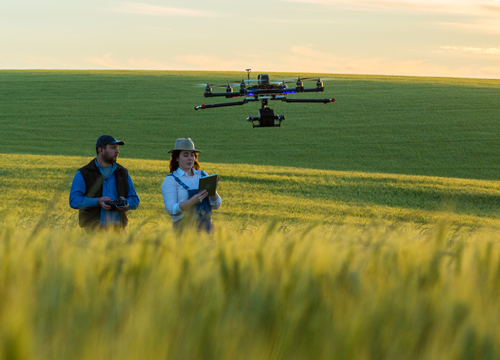Automated Food Production: Opportunities
Featured Signal of Change SoC1316

Food production accounts for a large portion of the world economy and affects billions of people. The UN World Population Prospects 2022 report projects that the global population will grow to 9.7 billion people by 2050, increasing the demand for food worldwide. To meet this demand, global food production must continue to increase. Automation in food production will be necessary to feed the growing population while reducing resource consumption. SoC1311 — Agricultural Robotics discusses robotic systems' potential to automate food production and explores associated challenges. The following bullets discuss additional opportunities in and relating to automated food production.
- Automated monitoring-and-management systems. Outdoor agriculture and aquaculture operations increasingly use data-driven management practices to optimize yields and minimize the use of inputs such as feed, fuel, and fertilizer. Software platforms integrate data from a wide variety of sources—including sensors, vehicles, satellites, drones, and infrastructure components—and offer recommendations for input use. For example, Agrivi is one of many companies that offer a software solution that integrates data from farm vehicles, drones, satellites, sensors, and other information sources and provides recommendations for farming practices. In some cases, monitoring-and-management platforms can link to agricultural machinery and direct the machines' actions. In combination with advances in agricultural robotics, monitoring-and-management platforms for agriculture could eventually automate the entire process of running a farm. Some automated monitoring-and-management platforms already enable partial automation of agricultural monitoring, data-driven planning, and task execution for specific machines. Indeed, a 2017 experiment at Harper Adams University demonstrated such a possibility across multiple machine types.
- Controlled-environment-agriculture automation. Operators of commercial greenhouses and artificial-light farms already make use of extensive automation to handle climate, lighting, irrigation, fertigation, hydroponic-system flow rates, and other environmental parameters. Small-scale fully automated greenhouses and artificial-light farms are already available for independent growers. Emerging advanced forms of greenhouse and nursery automation use robotic systems, including autonomous mobile robots. For example, Tortuga AgTech is developing fully automated greenhouse systems that incorporate robots for various plant-management tasks that humans would typically perform. Other ambitious systems, such as FarmPod's FarmPod, offer a fully automated, self-contained modular aquaponics system that produces both fish and produce simultaneously in a mutually reinforcing process. Current systems are too expensive to find widespread use. In the next ten years, mass-producing self-contained, automated controlled-environment-agriculture solutions at large scales could become possible, potentially enabling wide-scale localization of the production of produce, herbs, and other specialty crops.
- Automated indoor aquaculture. Indoor aquaculture systems are gaining popularity as a more environmentally friendly alternative to conventional sea-based or pond-based aquaculture—both of which have problems with environmental contamination. Indoor aquaculture systems can incorporate high levels of automation via use of systems similar to those that are in wide use in pond-based aquaculture. For example, Nordic Aquafarms is developing a highly automated indoor fish-farming facility that incorporates advanced filtration and waste-removal systems. Large-scale automated aquaponics systems from companies such as Upward Farms are also under development; such systems can use efficient natural processes to convert fish waste into fertilizer for hydroponic crops.
- Automated insect farming. Insect cultivation has slowly emerged as a solution for providing proteins for feed and for food products at large scales, with high efficiencies and small environmental footprints, and in urban centers. Automated, data-driven approaches for monitoring and yield optimization are quickly becoming common. More advanced solutions—such as Dilepix's insect-cultivation platform—are incorporating automated systems to help directly manage the insect-cultivation activities. Insect cultivation will likely become further automated, but it will likely face severe competition from the rapidly emerging synthetic-food industry.
- Synthetic foods. Various start‑ups are using advanced fermentation technology to convert glucose into proteins, vitamins, and other desirable biomolecules for use in food products (including plant-based meats) for human consumption and in animal feed. Other companies are growing engineered animal cells in bioreactors and then processing the resulting cells (using methods such as 3D bioprinting and collagen scaffolding) so that they have a desired shape and texture. Emerging systems have enormous disruptive potential; however, producers are having difficulty in achieving large scales, and processes are not yet highly automated. As the industry matures, fermentation-based systems will likely become highly automated, and production could scale up disruptively within the next ten years. Systems that use animal cells will likely have a much more difficult time in scaling up production, and highly automated large-scale production is unlikely within the next decade.
- Fishery automation. Large fishing trawlers (factory ships) are already highly automated, and the humans who perform tasks aboard the ships tend to have jobs that are extremely challenging to automate because they require flexibility, dexterity, and performance of complex activities. Nevertheless, additional automation will likely emerge in the next ten years—particularly in relation to environmental sustainability, regulatory compliance, and the tracking of food provenance. All these areas are currently seeing extensive development. For example, Open Ocean Robotics is developing solar-powered, autonomous oceangoing robots for use in monitoring protected fisheries for signs of illegal fishing.
- Livestock-factory automation. Intensive livestock farming is already very highly automated. Specialized robotic systems find use in the performance of specific tasks, including feeding, milking, and egg harvesting. Many technologies have been in continuous cycles of incremental improvement for several decades. Livestock-factory automation will likely continue to improve incrementally, and enterprises will increasingly adopt data-driven automated management-and-monitoring systems. But major market-disrupting innovations are unlikely. Instead, livestock farming might face its own major disruption from synthetic-meat technologies, which could increasingly deliver cheaper, better, and more environmentally friendly equivalents to dairy products and some meat products during the coming decade.